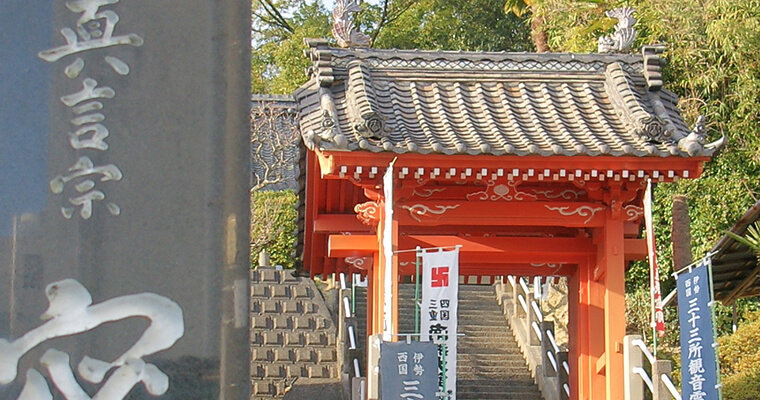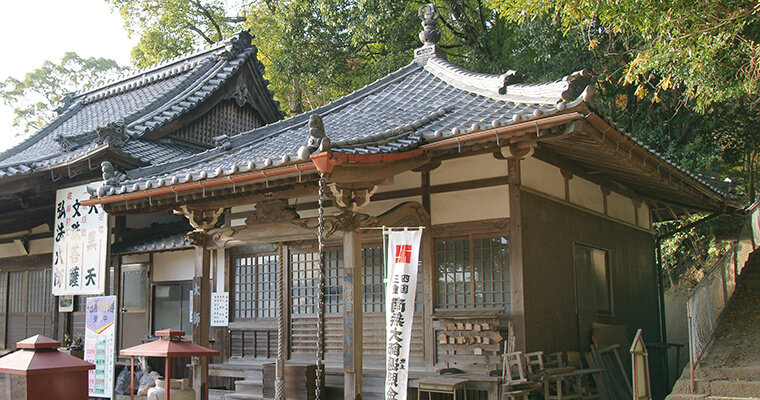Number 16Mitsuzō-in temple
History of the temple
In ancient times the area belonging to the temple was call Hakusan (the White Mountain). It was a praying place for the 2nd daimyo of Tsu province Tōdō Takatsugu (1602-1676), who worshiped Hakuzan Myōri Daigongen (a manifestation of a Bodhisattva in the form of a Shinto deity, originally a deity of Mount Haku one of Japan’s “Three Holy Mountains”).
During the Kanbun period (1661-1673) Takatsugu suffered from a disease believed to be a cause of a demon. He called the high priest Bokushin and ordered him to do exorcisms so he would recovery from illness. When Bokushin performed a secret incantations and prayers, Takatsugu immediately recovered from the illness. He was very glad and decided to donate the land of Hakusan, build a temple and enshrine his private small Buddhist statue in there. This was the beginning of Mitsuzō-in.
In the 1st year of Meiji period (1868-1912) small halls of Shikoku 88 Sacred Grounds were built in the mountain at the back of the Main Hall. The main statue of Mitsuzō-in is Senju Kannon (Thousand-Armed Kannon). There are many events organized at the temple, such as Daihōshikai Settai (party of Grand Master Club), Goeika kō (fraternal group of Buddhist song of praise) and Juzukuri (Buddhist rosary reeling). It is also a place of cultural exchange and is visited by many people.
Regrettably the temple lost its buildings and archives in a fire caused by a bombing of Tsu in 1945. Because the main statue was evacuated from the temple it survived the war unharmed. After the War the Main Hall and the Main Gate were rebuilt and maintenance of the road leading to the temple was finished. In 1980 a new Hakuzan Myōri Daigongen Hall was built on the mountain in the back of the temple.
The Main Hall enshrines the main statue of Senju Kannon, a statue of Kūkai, and a statue of Daikoku (God of wealth, farmers, food, and good fortune). On the right side of the Main Hall stands a cloister called Keion-in. In its Main Hall a statue of Bodhisattva Monju (Bodhisattva of Supreme Wisdom) is enshrined. A prayer for good school performance is also held in front of this hall. There are two stone statues standing in front of the Main Hall of Mitsuzō-in temple: Fudō Myō-ō (Immovable Wisdom King) and Bishamon (God of Treasure, Wealth, & Warriors). On the eastern side of the Hall stand a statue of Mizuko Jizō (Bodhisattva Jizō as a guardian of unborn, aborted, miscarried, and stillborn babies).
Until 1945 the Main Hall of Keion-in cloister used to be a sub-temple of Enichizan Tsu Kannon-ji temple. After the War it was moved to Mitsuzō-in’s precinct.
On the 21st of January, March, September and December a Daijuzukuri ritual (Buddhist rosary reeling ritual) is held. Dozens of people sit in a circle and pray chanting the Heart Sutra and passing around the rosary. This ritual is a well-known traditional Japanese ritual called Hyakumanben Juzu Kuri (Ritual of praying a million times while reeling the Buddhist rosary).
Mitsuzō-in is a temple number 65 of Mie Shikoku 88 Temples Pilgrimage.

Outline
-
Honorific name
Hakusan
-
Temple's name
Mitsuzō-in
-
Sect
Shingon Omuro branch
-
Religious service
Senju Kannon
(Thousand-Armed Kannon)





